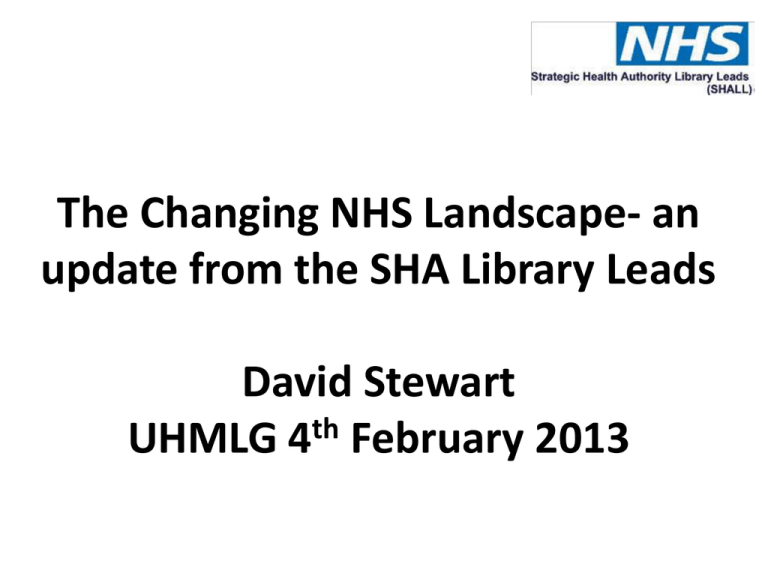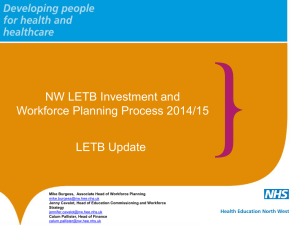David Stewart UHMLG
advertisement

The Changing NHS Landscape- an update from the SHA Library Leads David Stewart th UHMLG 4 February 2013 Context • Rationale for reform – Clinical leadership to drive improved outcomes and efficiency • Policy – Two white papers “Equity and Excellence: Liberating the NHS” outlines long-term vision for future of the NHS “Healthy Lives, Healthy People: Our Strategy for Public Health in England” focuses on the government’s vision for public health for the next 5 years • Economic context – Economic constraints challenging with £20bn national savings for current spending round • 2012 shadow year – New system fully operational from April 2013 NHS Reform 4 major, inter-related elements: • • • • Changes to the commissioning landscape Changes to the provider landscape Changes to the public health landscape Changes to the education and workforce landscape Supported by a revolution in patient information and involvement and a new role for local authorities The 2013 NHS landscape in summary Area Organisations Commissioning • NHS Commissioning Board (NHSCB) with national, regional and local area teams (LATs) which operate within a single operating model • NHSCB will be a non departmental public body and also host a range of bodies including clinical networks and senates, NHS Leadership Academy and CSS. It will have responsibility for some direct commissioning • Clinical Commissioning Groups (CCGs) • Commissioning Support Units (CSUs) Provision • NHS Trusts and National Trust Development Authority (NTDA) • Foundation Trusts (FTs) Public Health • Public Health England • Public health teams to Local Authorities Local Authorities • Health & wellbeing boards to produce needs assessment and health and well being strategy and promote integration Information and Involvement • Healthwatch (hosted by LAs) • Ten-year framework for transforming information for the NHS, public health and social care. Health and Social Care Information Centre Workforce • Health Education England • Local Education and Training Boards Commissioning - NHSCB • NHSCB – 1 National Support Centre, 4 regions and 27 LATs – Executive Non Departmental Public Body to have a mandate from Department of Health to improve outcomes through the total £80bn commissioning budget – Oversight and development of the commissioning system – Direct commissioning responsibility for primary care commissioning, offender and military health, specialised commissioning and some screening programmes – Sets key frameworks – outcomes, accountability, choice and emergency preparedness – Buys in some support from CSU – One national single operating model – Hosts some key bodies e.g. Senates Local area teams: roles and functions • All LATs will have the same core functions around: – – – – – – CCG development and assurance emergency planning, resilience and response quality and safety partnerships configuration system oversight • There will be variations around the scope of direct commissioning responsibilities: – 10 local area teams leading on specialised commissioning across England; – smaller number of local areas teams carrying out the direct commissioning of other services such as military and prison health; the model for the commissioning of NHS public health services and interventions still to be finalised. Clinical Senates Clinical Senates will work with Clinical networks to provide clinical advice at the strategic level Clinical Networks There are likely to be: • a small number of Strategic Clinical Networks (SCNs) across England hosted by NHS CB, plus • local networks, supported by CCGs and/or providers, may also be developed as locally determined • Core networks likely to be maternal and child health, mental health, cardiac and stroke and cancer The role of SCNs will be to support CCGs and the NHSCB improve outcomes, reduce variations, support innovation and increase productivity & efficiency. “The role of networks will be to provide leadership and insight rather than oversight and compliance” (SoS letter to Prof.Malcolm Grant, June 2012) Commissioning - CCGs • CCGs – 212 nationally – Power and responsibility for commissioning the majority of services for local people £60bn nationally – Clinically led – Membership organisations made up of constituent GP practices – £25 per head of population running cost allowance – Buy in support from CSUs (provided by NHS or non-NHS) – CCGs will be assessed against their progress on nationally set Clinical Outcomes (to be published late 2012) Commissioning - CSUs • CSUs – 22 nationally (and going down…) – Provide support to CCGs to prevent the need for them to have everything in house – Customer supplier relationship for services such as:• Health needs assessment • Service redesign • Business intelligence • Communications and Patient & Public Engagement • Contracting and procurement • Back office services such as payroll • Some services at scale – communications, Business Intelligence, clinical procurement and back office (meaning that some CSSs will provide to others) – Initial hosting by NHSCB until 2016 at the latest – Commercially minded and customer focussed organisations required to cover costs through income from customers (CCGs and NHSCB and potentially others) Public health - 1 • National outcomes framework for public health sets the broad public health and health inequalities outcomes for all areas and organisations to address. There is a clear focus on inequalities in service access within the NHS as part of tackling health inequalities. • A new dedicated public health service – Public Health England (PHE) will be created on 1st April 2013. This will be an executive agency of the Dept of Health and will; Provide services: health protection advice and support, intelligence and evidence products and national interventions such as media campaigns. Be an advocate for public health - championing better outcomes, promoting the evidence base and promoting innovation and best practice. Supporting and ensuring professional development for public health and jointly appointing (with local authorities) local Directors of Public Health. Public health - 2 • Locally, the public health function will be delivered by local authorities from 1st April 2013. • Local authorities will receive a ‘ring fenced’ allocation to spend on public health. • Public health advice will be delivered to Clinical Commissioning Groups – agreed via a local Memorandum of Understanding. • Local public health teams will be supported by Public Health England through local offices. • Some public health services such as screening and immunisation will be delivered through joint working with the NHS Commissioning Board Local Area Teams. • There will be an agreed ‘core offer’ of services between the NHSCB and Public Health England. Health and Wellbeing Boards • Health and wellbeing boards in every upper-tier and unitary local authority. • The boards will: – have the flexibility to bring in the expertise of district councils; – require local authorities to prepare the Joint Strategic Needs Assessment (JSNA) via health and wellbeing boards; – develop a shared view about community needs and support joint commissioning of NHS, social care and public health services; – have a proposed minimum membership of elected representatives, CCGs, directors of public health, directors of adults’ and children’s services, local HealthWatch representatives and the participation of the NHS commissioning board; - be able to expand membership to include voluntary groups, clinicians and providers. Healthwatch • Healthwatch launching in October 2012 is the new independent consumer champion created to gather and represent the views of the public. It: – plays a role at both national and local level – will be independent of Government through its constitution as a committee of the Care Quality Commission (CQC); • LINks will become local HealthWatch organisations – responsibilities will include: – providing a complaints advocacy service from 2013 to support people who make a complaint about services. – reporting concerns about the quality of health care to Healthwatch England, which can then recommend that the CQC take action. – Local authorities will be commissioners and funders of local HealthWatch organisations, and will also be subject to scrutiny from them in respect of their adult social care services. Education and workforce • There are two central planks to the new system: – Health Education England (HEE) – Local Education and Training Boards (LETBs). • HEE will provide national leadership and oversight on strategic planning and development of the workforce, and allocate education and training resources • Through HEE, providers will have strong input into the development of national strategies so education and training can adapt quickly to new ways of working and new models of service. LETBs may also take on specific leadership roles • LETBs will be the vehicle for providers and professionals to work with HEE to improve the quality of education and training outcomes so that they meet the needs of service providers, patients and the public. Introducing HEE The Reformed Education and Training System Secretary of State • Duty to maintain an effective system of education and training as part of comprehensive health service Secretary of State Department of Health • Set Education Outcomes Framework • Sponsor for HEE • Hold system to account, via HEE Department of Health NHS Commissioning Board Public Health England Health Education England • Accountable to SofS, via DH • Compliant with DH Education Outcomes and Performance Assurance Frameworks • Accountable to DH for allocation of education and training funding Health Education England • Set strategic Education Operating Framework (responding to input from PHE and NHSCB) NHS Commissioning Board • Input service commissioning priorities to HEE strategic Education Operating Framework Local Education and Training Boards Education and Research Public Health England • Input public health priorities to HEE strategic Education Operating Framework Local Stakeholders, including local authorities Health Service Providers 17 Local Education and Training Boards • Bring together Health, Education and Research sectors • Accountable to HEE for delivery against Education Operating Framework • Assessed against Education Outcomes Framework and Professional Regulators Health Education England (HEE) Health Education England (HEE) will, from October 2012, operate as a Special Health Authority (SpHA), accountable to the SofS. Longer term there is an intention that HEE will become an Executive NDPB. HEE’s mission is: “to ensure that the health workforce has the right skills, behaviours and training, and is available in the right numbers, to support the delivery of excellent healthcare and health improvement.” HEE has five key functions: 1. Providing national leadership on planning and developing the healthcare and public health workforce 2. Authorising and supporting the development of LETBs 3. Promoting high quality education and training, responsive to the changing needs of patients and local communities. This includes responsibility for ensuring the effective delivery of important national functions such as medical trainee recruitment 19 4. Allocate and account for NHS education and training resources and the outcomes achieved 5. Ensuring the security of supply of the professionally qualified clinical workforce The Vision for HEE ‘World class healthcare education and training, supporting world class healthcare’ Objectives are to provide a healthcare education and training system that: Gives providers greater scope and responsibility to plan and develop their workforce, whilst being professionally informed and underpinned by strong academic links Ensure security of supply of the healthcare workforce in terms of numbers staff and skills Aspires to excellence in education and training leading to better experience for patients, students and trainees and world class health outcomes Supports NHS values and behaviours to provide person-centred care Supports the development of the whole workforce, within a multi-professional and UK-wide context Supports innovation, research and quality improvement Provides greater transparency, fairness and efficiency to the investment made in education and training Reflects the explicit duty of the Secretary of State to secure an effective system for education and training 20 Health Education England “HEE will provide leadership for the new education and training system. It will ensure that the shape and skills of the future health and public health workforce evolves to sustain high quality outcomes for patients in the face of demographic and technological change” “HEE will ensure that the workforce has the right skills, behaviours and training and is available in the right numbers, to support the delivery of excellent healthcare and drive improvement. HEE will support healthcare providers and clinicians to take greater responsibility for planning and commissioning education and training through development of the Local Education and Training Boards (LETBs) which are statutory committees of HEE” The Education Outcomes Framework 1. Excellent education Excellent experience for staff (inc. students / trainees) and patients 2. Competent and capable staff Ensure the health workforce has the right skills, behaviours and training, available in the right numbers, to support the delivery of excellent healthcare and health improvement 3. Adaptable and flexible workforce Effectiveness 4. NHS values and behaviours Safety 5. Widening participation Aim Domains Quality HEE Advisory structure Professional Bodies Strategic Advisory Forum Health Education England HEE/LETB Partnership Group Patient’s Forum 23 Four stages of HEE implementation 24 HEE Culture and values Core values - Respect and dignity - Commitment to quality care - Compassion - Improving lives - Working together for patients - Everyone counts • Pride in working for HEE • Pride in being a healthcare professional Outcomes The only reason HEE exists is to ensure high quality care is delivered to patients Success criteria • • • • Improvements in safety Improvements in experience Improvements in clinical outcomes Innovation The new landscape - LETBs • There will be 13 LETBs (at the time of writing !) • LETBs operating in shadow form, with delegated authority from current SHA • Authorisation Criteria and Process published July 2012 • LETB Independent Chair posts currently out to advert for appointment by October 2012 How HEE will work with LETBs • HEE will not be a regulator breathing down the neck of LETBs • HEE will focus on ‘what’ needs to be delivered. LETBs will focus on ‘how’ this will happen locally • HEE will agree national objectives, LETBs will have delegated resource to get on with it • A distributed model of leadership Academic Health Science Networks (AHSNs) • Primary purpose – “to enhance the transfer of successful innovations into clinical practice through partnership working between healthcare providers, universities, local government and industry” • AHSNs will cover the whole country • Links to: Research participation Translating research & learning into practice Education and training Service improvement Information Wealth creation Any Questions?







